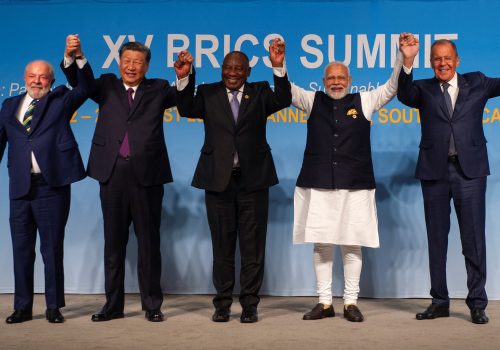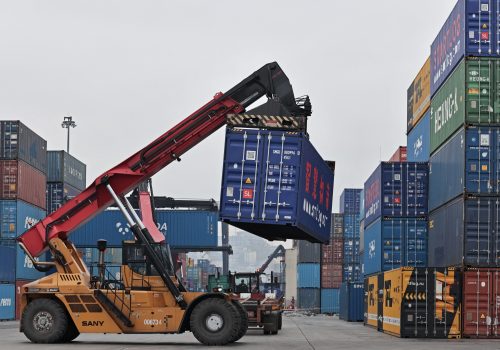Indonesia’s economy will surpass Russia’s sooner than expected. Here’s what that says about the global economy.
In 1890, Russian prince Nicholas Alexandrovich, who would soon become Czar Nicholas II, took a trip across Asia. In February his cruise ships dropped anchor in the Bay of Batavia (modern day Jakarta Bay) on the island of Java. He spent several weeks touring the island, complaining about the heat, and hiking volcanoes. Little could the prince imagine that over a century later the island—and its neighbors—would be poised to leapfrog Russia as one of the largest economies in the world:
In 2026, Indonesia is expected to surpass Russia to become the world’s sixth largest economy (in PPP terms)—about two years earlier than if Putin’s invasion of Ukraine had never happened. (We reached that estimate by comparing the IMF’s growth projections pre- and post-invasion.)
This is not directly a sanctions story. Yes, financial sanctions and lack of access to advanced technology through export controls have significant negative long-run effects on the Russian economy. But Russia’s slide and Indonesia’s ascent are both driven in large part by the same thing: people. Russia is suffering from acute brain drain while Indonesia’s labor force is growing. In particular, Indonesia’s educated professional class is growing while Russia’s is shrinking. That contrast is what makes their soon-to-be swap on the list of the world’s largest economies notable. The world’s center of economic gravity is shifting.
In Russia, working citizens under the age of 35 now comprise less than 30 percent of the labor force, the lowest share since Russia started collecting that data twenty years ago. And here’s a statistic which should scare all Russian policymakers: from the start of the invasion to spring 2023, 86 percent of Russian emigrants are under the age of 45 and 80 percent are college educated. In the coming years, Russia’s labor supply will shrink as potential migrants view the country less favorably and as its living standards converge with other former Soviet republics, Moscow’s traditional source of migration. This, coupled with declining birth rates, means that by 2040 a declining workforce could reduce GDP growth by as much as 0.5 percent, according to projections like those by Bloomberg Economics.
Meanwhile Indonesia’s labor force is growing, its commodity exports are booming, and its new capital is under construction. There is a reason why Xi Jinping reportedly tried so hard to bring Indonesia into the BRICS expansion this week. He knows very well where the future is heading: it’s to China’s south, not its north.
While Russia’s workforce ages and its education levels decline, Indonesia’s continue to improve as new workers enter the labor force with strong educational backgrounds and important skills, albeit at a slower rate than the two decades prior to COVID. A growing and more prosperous labor force has also provided a strong foundation for increases in Indonesian private consumption. This is particularly important for China as it searches for new consumer markets to absorb its exports. Although Russia may be an important export market for Chinese producers for the moment, as it rushes to fill the gaps left as western companies pull out, its long-term growth prospects are stagnant at best and more likely negative. The opposite is true for Indonesia, which is still mostly on track to achieve its goal of becoming a High-Income Country by 2045.
Indonesia can see its brighter economic future ahead and its refusal so far to join the BRICS expansion speaks to its own growing confidence—and was one of the most significant and overlooked developments of last week.
The data shows that Russia will increasingly need benefactors like China to prop up its economy while rising powers like Indonesia will have many more friends eager to do business across the islands.
Josh Lipsky is the senior director of the Atlantic Council GeoEconomics Center and a former adviser to the International Monetary Fund.
Niels Graham is an associate director for the Atlantic Council GeoEconomics Center where he supports the center’s work on China’s economics and trade.
This post is adapted from the GeoEconomics Center’s weekly Guide to the Global Economy newsletter. If you are interested in getting the newsletter, email SBusch@atlanticcouncil.org
Further reading
Thu, Aug 24, 2023
BRICS is doubling its membership. Is the bloc a new rival for the G7?
New Atlanticist By
Atlantic Council experts share their insights on what the addition of Argentina, Egypt, Ethiopia, Iran, the UAE, and Saudi Arabia to the group might mean.
Tue, May 30, 2023
China is trading more with Russia—but so are many US allies and partners
New Atlanticist By Josh Lipsky, Niels Graham
A number of countries have increased their trade with Russia since its full-scale invasion of Ukraine in early 2022, including non-aligned countries and even some EU members.
Thu, Aug 17, 2023
The Chinese economy’s moment of macro weakness—in charts
Econographics By Niels Graham
The Chinese economy is weakening as seen through indicators related to its property and manufacturing sectors, unemployment, inflation, and trade.
Image: The never-ending development in the big city of Jakarta.


